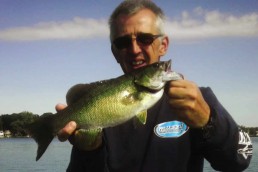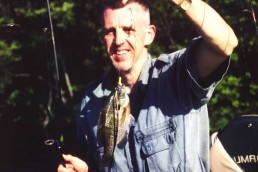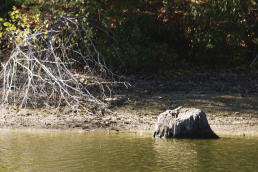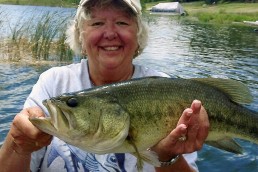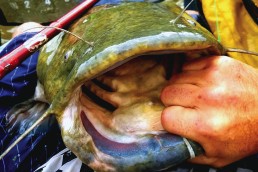Green Cabbage might be King of all Fish-holding Weeds
SHARE THIS POST
For most of my fishing career I’ve enjoyed the broadleaf cabbage weeds. Virtually all species of fish relate to this wonderful growth. What many anglers fail to understand is how to fish it and that gamefish and panfish often live in good cabbage.
I host an outdoor radio show and enjoy the guests; countless guides and tournament angers have graciously been on the air with me. What I did not know was that many of them do concentrate on the cabbage weeds.
Capt. Lance Valentine and Capt. Ken Clark both guide on plenty of lakes, and both zero in on any good weed bed. Now, if a guide is fishing cabbage weeds during the middle of summer, I think that we should as well. Capt. Valentine works the weeds of Saginaw Bay when many anglers are out in the deeper basin. Here, the weeds and edges hold all species.
The master angler list reports that Houghton Lake produces the largest number of master angler bluegills in the state. Talk to the tackle shops on Houghton and they will point to the various weed beds.
Tackle requirements are simple, as slip bobbers, jigs and ‘crawler harness rigs will handle much of the walleyes and the bass. Slip floats, small plastic action tails and mini-spinners will handle the perch, ‘gills and crappies; spinners or swimbaits will handle the pike action.
Spinners take fish, and a ‘crawler harness pulled over the weeds with a bullet sinker in front will take countless walleyes. If we are trolling over the tops we use a 1/16- or a 1/8-ounce bullet sinker. Place the bullet sinker on first then tie on a barrel swivel and then the spinner. I like a 4-foot leader made out of fluorocarbon. The bullet sinker will grab much of the weeds; using the lightest sinker possible keeps you above the majority of them.
Hand-sized ‘gills will hammer on a small spinner with a Belgium worm. We tie our own mini-worm spinners and use either a number 0 or a number 1 Colorado blade. We use very small glass beads in front of the first hook—Hobby Lobby has a good selection of beads. Fish this in the same manner as a nightcrawler harness. Also, let it sink and retrieve bait.
Next, we use a Northland Tackle Whistler jig head. We use the 1/16- up to the 1/4-ounce heads. This jig has a small propeller blade that throws off vibration and cuts the weeds. The beauty of this jig is that it can be fished over the tops of the weeds and skimmed across the bottom and through the small pockets—just deadly on all species.
A slip float can be tossed into a small opening or fished long the weedline’s edge. With a moderate wind it becomes a great drifting tool. I almost always have a slip float out while casting or drifting and use a spinner on a second rod. No sinker is needed with a slip float if you use a jig. And a 1/8-ounce jig head tipped with a leech or a minnow works on bass, walleyes and crappies. An ice fishing teardrop and one single number 7 split shot tipped with a waxworm slams the big ‘gills.
Are you enjoying this post?
You can be among the first to get the latest info on where to go, what to use and how to use it!
Floats perform two tasks perfectly: they keep your lure or bait exactly at the depth you desire and are a spectacular strike indicator. You have fixed floats and slip floats. A fixed float is attached to your line and stays at that exact depth, while a slip float is adjustable for any depth, and is my favorite.
Pike or muskies can be great with a large sucker minnow floating 2 to 4 feet down over and alongside a cabbage weed patch. Use the biggest sucker minnows or chubs you can find. Hook your bait with a quick-strike rig to avoid gut-hooking the fish. A quick-strike rig has two hooks: one goes into the mouth and the other under the dorsal fin parallel to the fish’s body. I could never pass up a cabbage patch without flinging out either a Mr. Twister Tail or a Charlie Brewer Grub. For the panfish, I stick with the 1/16-ounce heads, maybe 1/8 ounce on a windy day. The 2-inch Twister Tail works great on crappies, as does the Brewer Grub. For bluegill-lovers, try a Whip’R Snap jig tipped with a waxworm. For walleyes, pike and bass, try swimbaits.
Where do you fish on a large cabbage flat? Start off drifting or slow-trolling over the top. If the weeds are not too close to the surface, this is a great way to pinpoint some fish and test their aggressiveness. If the weeds are touching the surface, then look for any points sticking out, or pockets or inside turns. Most weed beds have jagged edges and little points that protrude. They can turn or meet a drop-off or the bottom content can change, leaving an opening in the weeds. Drop an anchor or use the anchor mode on your trolling motor. If it’s breezy, try anchoring upwind and on a quartering line so that you can cast quartering into the wind and drift your float into an opening. On Houghton Lake, we are amazed at the number of anglers anchoring at low light and fishing slip floats or jigs on the outer edges of the weeds—any change in the depth to a weedline can be great.
During the dog days of summer, find an isolated cabbage patch; this is a true honey hole. Some of our best summer locations like these are the size of a house. A slight hump coming from the deeper water that is ringed with cabbage weeds draws tons of fish. Watch your graph; it will show weeds. Also, on a calm day you can see tips barely ticking the surfaces. Mark these locations with your GPS.
Some of my favorite lakes with guides include Hamlin Lake in Ludington. Early in the season the upper section is good, and once summer arrives the lower section is fabulous. Huge cabbage beds can be found along the dunes and on the east shoreline. On the west or dune side there are many nice pockets to fish and are not overly packed together.
On Lake Leelanau, there are thin bands of weeds on both the east and west shorelines and a huge bed on the southern end of the lake. On a calm morning or evening, the cabbage weeds erupt with feeding walleyes. Houghton Lake has some great weed beds. My favorite is straight off of the motel that borders the public launch on old U.S. Highway 27. This weed bed starts and stops covering nearly two miles, and depths vary from 8 to 12 feet—just an awesome place for ‘gills, crappies and walleyes.
Lake Cadillac and Lake Mitchel are two other favorites. Near the center of Lake Cadillac is a twisty turning weed bed that lights up around the first of June and continues all summer. There are so many points sticking off of it and the pretzel-shaped weed bed has tons of hiding locations and deep waters. On Mitchell, there are two very large weed beds and we do our best working the 10- to 12-foot edge. Most days there will be a slight breeze that facilitates a drift nicely.
Cabbage weeds harbor fish all season, and more gamefish are caught by accident during the summer than those actually targeted on a good weed bed. Remember to listen to the guides and tournament anglers, and fish the green. MWO
MWO
SHARE THIS POST
Did you enjoy this post?
You can be among the first to get the latest info on where to go, what to use and how to use it!
Jack Payne
Jack Payne is an accomplished angler and hunter who enjoys teaching others as much as learning from others. Seminar speaker, outdoor photography enthusiast, hunter safety instructor and volunteer at many events for both kids and adults as an instructor.
